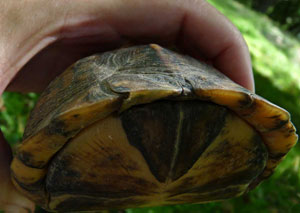While Doug and I were camping in the hills of West Virginia in late September, we saw five box turtles in one day. I can’t recall ever seeing a box turtle in Connecticut. It turns out that our state is near the limit of their northeastern range. Another reason they are uncommon is human activity.
The maximum lifespan of a box turtle could be as much as 138 years (Nigrelli 1954). That could span six generations of humans. In the wild, they are probably lucky to live 30-40 years. Many end up as flattened fauna on roads that fragment their habitat or separate them from nesting sites. Since it takes them about 20 minutes to travel 100 yards (the length of a football field), it would be impossible for them to avoid an oncoming vehicle.
 |
Box turtles got their name from their helmet-shaped upper shell and the fact that they can close up like a box. The plastron has hinges in the front and the back that can be pulled up like drawbridges to protect them from predators. To make room, they expel air in their lungs and twist their heads in an “S” shape. This box turtle was seen in West Virginia. Bet Zimmerman photo. |
Another threat is loss of wetlands and vernal pools. Even though box turtles live on dry land, they still need access to water to drink, cool off and forage. They also seem to like to defecate in water.
Habitat changes that increase predators likes dogs and raccoons also affect populations. Unlike deer, if the numbers of adults is reduced, turtles do not compensate by reproducing more. Box turtles take about a decade to reach breeding age. They only have 3-6 eggs in each clutch, laying several clutches a year. Out of hundreds of eggs, probably only a couple hatchlings will survive to adulthood.
Eastern box turtles (Terrapene carolina carolina) tend to be found near forest-field edges with plenty of underbrush, and close to water. Their range is small - only about 750 feet in diameter. They are seldom found on land that is higher than 700 feet in elevation (Source: Klemens 1993.)
They are active during the day.
These omnivores eat almost anything that fits in their mouth, such as vegetation, small fruits and mushrooms (including those that are toxic to humans), insects and other critters (especially worms and slugs.) They will also eat carrion (dead meat), and have been observed eating dead ducks and even chowing on a dead cow.
During winter, box turtles hunker down in loose soil and leaf litter to hibernate for several months, sometimes returning to the same spot year after year. Like wood frogs, box turtles have antifreeze-like cryoprotectants in their system. Box turtles can survive gradual partial freezing for a few days, but a sudden cold snap could kill them.
New England box turtles are bigger than those I saw in the south. All vary a lot in appearance. Males tend to have bright red eyes, while most females have brown eyes. Males have a depression in the rear part of the plastron (the bottom part of the shell), while the plastron on a female is almost completely flat.
You can imagine that mating might be a bit tricky. Sometimes it can even be deadly. After courtship, which consists of circling, biting and shoving, the male mounts the female at a precipitous angle. On occasion, he falls over backwards. If he cannot right himself, he will starve to death. Fortunately females can store the sperm and lay fertile eggs for up to four years after a successful mating.
Collecting for the pet trade also impacted populations. It is illegal to collect box turtles from the wild without a permit in most states, including CT. Besides, wild caught turtles often have protozoan and bacterial infections, including Salmonella which is easily transmitted to humans.
CT law limits possession of box turtles to a single animal. The care and feeding of box turtles is more complicated than most people realize. As far as children are concerned, they make pretty boring pets. If, after doing your homework, you really do want a box turtle, contact a herpetological society, turtle and tortoise group, reptile rescue group, or animal shelter to see about adopting a turtle that needs a home.
Never let a pet box turtle loose in the wild. Besides potentially spreading disease to wild populations, this would probably be a death sentence. Relocated turtles have a homing instinct. When released, they will head for the place where they are born, increasing their odds of being killed.
To help wild box turtles, leave leaf litter and fallen woody debris on the forest floor. Obey speed limits to allow you to avoid a turtle on the road. If you see a turtle trying to cross a busy road and can SAFELY stop, pick it up and move it to the other side in the direction it was facing. Otherwise, if you are lucky enough to see a box turtle wandering in the wild, please leave it be. |

